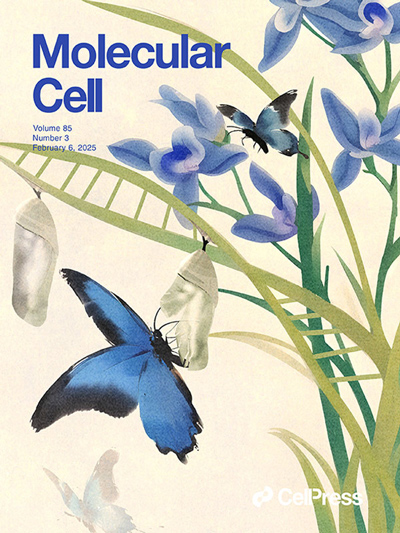Volume 85, numero 3
Zhanzhan Xu1,4 ∙ Chen Nie1,4 ∙ Junwei Liao1 ∙ Yujie Ma1 ∙ Xiao Albert Zhou1 ∙ Xiaoman Li1 ∙ Shiwei Li1 ∙ Haodong Lin1 ∙ Yefei Luo1 ∙ Kaiqi Cheng1 ∙ Zuchao Mao1 ∙ Lei Zhang1 ∙ Yichen Pan1 ∙ Yuke Chen2 ∙ Weibin Wang1 weibinwang@bjmu.edu.cn ∙ Jiadong Wang1,3,5

La copertina di questo numero di Cellula molecolare È "DDX39A risolve gli ibridi RNA-DNA associati alla forcella di replicazione per bilanciare la protezione della forcella e la scissione per il mantenimento della stabilità genomica" pubblicato da Il professor Wang Jiadong E Ricercatore associato Wang Weibin dell'Università di Pechino.

Contesto della ricerca
Durante la replicazione del DNA, garantire la stabilità delle forcelle di replicazione nelle regioni trascrizionalmente attive è essenziale per una replicazione accurata e per prevenire mutazioni. Le forcelle di replicazione sono due strutture a forma di Y che srotolano la doppia elica e avanzano in entrambe le direzioni durante la replicazione del DNA. Nelle regioni trascrizionalmente attive, può generarsi un ambiente molecolare complesso a causa dell'attività simultanea di RNA polimerasi e DNA polimerasi, che rappresenta una sfida per la stabilità delle forcelle di replicazione. Il contesto di questo studio si basa sulla questione scientifica di come mantenere la stabilità delle forcelle di replicazione nelle regioni trascrizionalmente attive per prevenire danni al DNA e mutazioni.
Significato della ricerca
Questo studio ha scoperto per la prima volta ibridi RNA-DNA associati alla forcella di replicazione (RF-RD) ubiquitari in regioni trascrizionalmente attive di cellule umane. Questi ibridi agiscono come una barriera protettiva che previene la degradazione del DNA nascente mediata da DNA2 e il collasso della forcella di replicazione sotto stress replicativo. Questa scoperta rivela una nuova funzione delle interazioni RNA-DNA nel mantenimento della stabilità della forcella di replicazione. Lo studio ha anche identificato DDX39A come una proteina associata a RAD51 che si lega alle forcelle di replicazione bloccate e risolve i RF-RD, promuovendo così la resezione del DNA mediata da DNA2 e il riavvio della forcella di replicazione. Questa scoperta offre una nuova prospettiva per comprendere il riavvio della forcella di replicazione e la riparazione dei danni al DNA.
Lo studio ha inoltre dimostrato che un'eccessiva dissoluzione dei RF-RD può portare al collasso della forcella di replicazione e all'instabilità genomica, mentre una dissoluzione insufficiente dei RF-RD in condizioni di stress replicativo aumenta la stabilità della forcella di replicazione e porta alla resistenza alla chemioterapia. Questa scoperta sottolinea il ruolo di bilanciamento dei RF-RD nel mantenimento della stabilità della forcella di replicazione e della sensibilità alla chemioterapia.
Prospettive di ricerca
Sulla base del ruolo chiave degli RF-RD nel mantenimento della stabilità della forcella di replicazione e della sensibilità alla chemioterapia, studi futuri potranno esplorare il targeting degli RF-RD come nuova strategia per migliorare l'efficacia della chemioterapia. Regolando la formazione e la dissoluzione degli RF-RD, potrebbe essere possibile migliorare la risposta di alcuni pazienti oncologici ai farmaci chemioterapici. Sebbene questo studio abbia rivelato il ruolo degli RF-RD e di DDX39A nella stabilità della forcella di replicazione, rimangono ancora molti misteri irrisolti. Ad esempio, lo specifico meccanismo di formazione degli RF-RD, il modo in cui DDX39A riconosce e si lega alle forcelle di replicazione bloccate e l'interazione tra gli RF-RD e altri meccanismi di riparazione del DNA sono tutte direzioni importanti per la ricerca futura.
Per studiare più approfonditamente i RF-RD e la stabilità delle forche di replicazione, è necessario sviluppare nuovi strumenti e tecnologie per monitorare in tempo reale la formazione, i cambiamenti dinamici e l'interazione dei RF-RD con le forche di replicazione. Questi strumenti e tecniche contribuiranno a svelare maggiori dettagli sui meccanismi di replicazione e riparazione del DNA.
Processo di progettazione della copertina
I nostri orari
Lun 21/11 - Mer 23/11: 9:00 - 20:00
Gio 24/11: chiuso - Buon Ringraziamento!
Venerdì 25/11: 8:00 - 22:00
Sab 26/11 - Dom 27/11: 10:00 - 21:00
(tutti gli orari sono l'ora di New York)